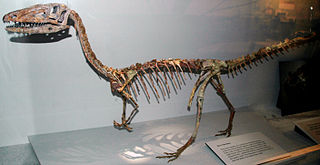
Coelophysis is a genus of coelophysid theropod dinosaur that lived approximately 215 to 208.5 million years ago during the Late Triassic period from the middle to late Norian age in what is now the southwestern United States. Megapnosaurus was once considered to be a species within this genus, but this interpretation has been challenged since 2017 and the genus Megapnosaurus is now considered valid.

Aetosaurs are heavily armored reptiles belonging to the extinct order Aetosauria. They were medium- to large-sized omnivorous or herbivorous pseudosuchians, part of the branch of archosaurs more closely related to crocodilians than to birds and other dinosaurs. All known aetosaurs are restricted to the Late Triassic, and in some strata from this time they are among the most abundant fossil vertebrates. They have small heads, upturned snouts, erect limbs, and a body ornamented with four rows of plate-like osteoderms. Aetosaur fossil remains are known from Europe, North and South America, parts of Africa, and India. Since their armoured plates are often preserved and are abundant in certain localities, aetosaurs serve as important Late Triassic tetrapod index fossils. Many aetosaurs had wide geographic ranges, but their stratigraphic ranges were relatively short. Therefore, the presence of particular aetosaurs can accurately date a site in which they are found.
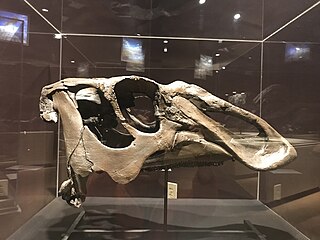
Naashoibitosaurus is a genus of hadrosaurid dinosaur that lived about 73 million years ago, in the Late Cretaceous, and was found in the Kirtland Formation of the San Juan Basin in New Mexico, United States. Only a partial skeleton has been found to date. It was first described as a specimen of Kritosaurus by Jack Horner, and has been intertwined with Kritosaurus since its description.

The Gnathorhizidae are an extinct family of lungfish that lived from the late Carboniferous until the middle Triassic. Gnathorhizid fossils have been found in North America, Madagascar, Australia, and possibly Eastern Europe and South Africa. They are characterized by high-ridged toothplates that form cutting blades and a reduction in cranial bones.

Chinlea is an extinct genus of late Triassic Mawsoniid coelacanth fish found in and named after the Chinle Formation that crops out in the southwestern states of Arizona and New Mexico. The word “Chinle” comes from the Navajo word meaning "flowing out", referencing the location where water flows out of the Canyon de Chelly. They were also possibly found in the Dockum Group.

Hesperosuchus is an extinct genus of crocodylomorph reptile that contains a single species, Hesperosuchus agilis. Remains of this pseudosuchian have been found in Late Triassic (Carnian) strata from Arizona and New Mexico. Because of similarities in skull and neck anatomy and the presence of hollow bones Hesperosuchus was formerly thought to be an ancestor of later carnosaurian dinosaurs, but based on more recent findings and research it is now known to be more closely related to crocodilians rather than dinosaurs.
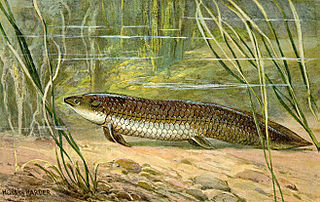
Ceratodus is an extinct genus of lungfish. It has been described as a "catch all", and a "form genus" used to refer to the remains of a variety of lungfish belonging to the extinct family Ceratodontidae. Fossil evidence dates back to the Early Triassic. A wide range of fossil species from different time periods have been found around the world in places such as the United States, Argentina, Greenland, England, Germany, Egypt, Madagascar, China, and Australia. Ceratodus is believed to have become extinct sometime around the beginning of the Eocene Epoch.
Redondasaurus is an extinct genus or subgenus of phytosaur from the Late Triassic of the southwestern United States. It was named by Hunt & Lucas in 1993, and contains two species, R. gregorii and R. bermani. It is the youngest and most evolutionarily-advanced of the phytosaurs.
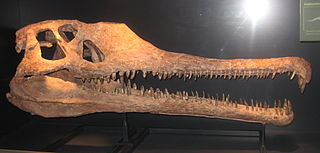
Angistorhinus is an extinct genus of phytosaur known from the Late Triassic period of Texas and Wyoming, United States. It was first named by Mehl in 1913 and the type species is Angistorhinus grandis. Other species from Texas and Wyoming, A. alticephalus, A. gracilis and A. maximus, are cospecific with the type species. Angistorhinus is known from the holotype UC 631, partial skull and lower jaws recovered from the Popo Agie Formation, Chugwater Group, Wyoming and from the associated paratype UM 531, a partial skull, TMM 31098-1, skull and lower jaws and ROM 7977, partial skull and lower jaws, recovered from the 'Pre-Tecovas Horizon' in the Dockum Group, Texas. A possible second species, A. talainti is known from the Triassic of Morocco. In 1995, Long and Murry created the new combination, Angistorhinus megalodon by synonymy for Brachysuchus. Hungerbühler and Sues (2001) hypothesised that Angistorhinus is a junior synonym of Rutiodon. However, in 2010 Michelle R. Stocker retained the validity of Brachysuchus and of A. grandis.

Arganodus is an extinct genus of Ceratodontidae (lungfish). It´s fossils where found first at Tizi n'Maâchou in the Marrakech area of Morocco, in rocks of the Timezgadiouine Formation, that belong to the Argana Group. Other specimens have been found in the Redonda Formation, New Mexico, the Anoual Formation of Morocco, the Tacuarembó Formation of Uruguay, and the Cumnock Formation, North Carolina, although the North Carolinian specimens are smaller than most recorded specimens. Fossils have also been uncovered in the Petrified Forest National Park. It was first named by Martin in 1979, and contains two species, A. dorotheae and A. atlantis. In 1984, Martin described Arganodus tiguidiensis from Elrhaz Formation of Niger extending its stratigraphic range from the Upper Jurassic to the Cenomanian. Later, this species was assigned to the genus Asiatoceratodus by Kemp (1998).

Apachesaurus is an extinct genus of metoposaurid temnospondyl amphibian from western North America.
Dictyocephalus is an extinct genus of prehistoric temnospondyls; the only species is Dictyocephalus elegans. This taxon was one of the first metoposaurids to be discovered in North America, being discovered by Ebeneezer Emmons and briefly described by Joseph Leidy in 1856 in the Newark supergroup exposures of Chatham County, North Carolina. At the time, Leidy was uncertain of much of the anatomy of D. elegans, which is represented only by a small partial skull and made only brief descriptions and measurements of a few elements, with an estimated size based on the long-snouted trematosaur Trematosaurus. Emmons provided the first figures of the specimen the following year. Romer (1947) briefly mentioned that the specimen was indistinguishable from "Buettneria" (Koskinonodon).

Anaschisma is an extinct genus of large temnospondyl amphibians. These animals were part of the family called Metoposauridae, which filled the crocodile-like predatory niches in the late Triassic. It had large skull about 62 centimetres (24 in) long, and possibly reached 3 metres (9.8 ft) long. It was an ambush hunter, snapping up anything small enough to fit in its huge jaws. It was very common during the Late Triassic in what is now the American Southwest.

Ptychoceratodus is an extinct genus of lungfish living from Early Triassic to Middle Jurassic. It was established by Otto Jaekel for one species, transferred from Ceratodus genus. Type species is P. serratus from the Middle Triassic of Switzerland and Germany. Ptychoceratodus had two pairs of massive dental plates, bearing 4-6 acute ridges. Its skull roof was composed from massive, plate-like bones. In the central part of skull roof was localized an unossified fenestra. Most of the Ptychoceratodus findings are isolated dental plates, some associated with jaws. Other parts of skull or postcranial skeleton are relatively rarely found as fossils. The anatomy of skull is the best recognized in P. serratus, whereas less complete cranial material is available also for P. concinuus, P. phillipsi, and P. rectangulus. Although Ptychoceratodus is known exclusively from the Triassic and Jurassic, there were also Cretaceous specimens referred to this genus. However, they are more often regarded as representants of Metaceratodus. Ptychoceratodus is the only member of the family Ptychoceratodontidae. The first named species is P. phillipsi by Louis Agassiz in 1837 as a species of Ceratodus and later moved to Ptychoceratodus genus. Occurrences of Ptychoceratodus come mainly from Europe. However, occurrences from other continents suggest it was dispersed globally during the Triassic. After 2010, the new fossil material behind the Europe was reported from South America, India, and Greenland

Leptosuchus is an extinct genus of leptosuchomorph phytosaur with a complex taxonomical history. Fossils have been found from the Dockum Group and lower Chinle Formation outcropping in Texas, New Mexico, and Arizona, USA, and date back to the Carnian stage of the Late Triassic.

Machaeroprosopus is an extinct genus of mystriosuchin leptosuchomorph phytosaur from the Late Triassic of the southwestern United States. M. validus, once thought to be the type species of Machaeroprosopus, was named in 1916 on the basis of three complete skulls from Chinle Formation, Arizona. The skulls have been lost since the 1950s, and a line drawing in the original 1916 description is the only visual record of the specimen. Another species, M. andersoni, was named in 1922 from New Mexico, and the species M. adamanensis, M. gregorii, M. lithodendrorum, M. tenuis, and M. zunii were named in 1930. Most species have been reassigned to the genera Smilosuchus, Rutiodon, or Phytosaurus. Until recently, M. validus was considered to be the only species that has not been reassigned. Thus, Machaeroprosopus was considered to be a nomen dubium or "doubtful name" because of the lack of diagnostic specimens that can support its distinction from other phytosaur genera. However, a taxonomic revision of Machaeroprosopus, conducted by Parker et al. in 2013, revealed that UW 3807, the holotype of M. validus, is not the holotype of Machaeroprosopus, while the species Machaeroprosopus buceros, Machaeroprosopus being a replacement name, with a fixed type species, for Metarhinus, is the combinatio nova of the type species of the genu: Belodon buceros. Therefore, the name Pseudopalatus must be considered a junior synonym of Machaeroprosopus, and all species of the former must be reassigned to the latter. This revised taxonomy was already accepted in several studies, including Stocker and Butler (2013). Stocker and Butler (2013) also treated M. andersoni as a valid species, and not a junior synonym of Machaeroprosopus buceros as was previously suggested by Long and Murry (1995).
Kayentavenator is a genus of small carnivorous tetanuran dinosaur that lived during the Early Jurassic Period; fossils were recovered from the Kayenta Formation of northeastern Arizona and were described in 2010.
Ordosiodon is an extinct genus of therocephalian therapsids from the Early Triassic of China. It includes two species, O. lincheyuensis and O. youngi.

Warrenisuchus is an extinct genus of temnospondyl amphibian from the Early Triassic of Queensland, Australia. It belongs to a diverse group of Triassic temnospondyls called Capitosauria. The type species Warrenisuchus aliciae was erected in 2009. W. aliciae was originally described as a species of Parotosuchus in 1988, which is known from other species that have been found in Europe, Africa, and Antarctica. In 2000 it was then assigned to a new genus called Rewanobatrachus along with the newly named species R. gunganj, which was declared the type species of the genus. However, R. gunganj was later reclassified as a species of Watsonisuchus, invalidating the name Rewanobatrachus and requiring that R. aliciae be placed in its own genus, which was named Warrenisuchus. However, several studies suggest that Warrenisuchus aliciae may be a species of Watsonisuchus as well. Unlike most capitosaurs, Warrenisuchus is known from many juvenile skulls less than 4 centimetres (1.6 in) in length.
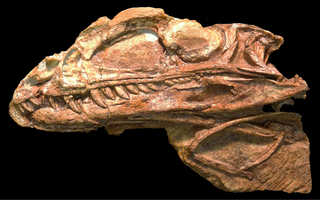
Coelophysis? kayentakatae is an extinct species of neotheropod dinosaur that lived approximately 200–196 million years ago during the early part of the Jurassic Period in what is now the southwestern United States. It was originally named Syntarsus kayentakatae, but the genus Syntarus was found to be preoccupied by a Colydiine beetle, so it was moved to the genus Megapnosaurus, and then to Coelophysis. A recent reassessment suggests that this species may require a new genus name.
















